
22 Days Northwestern Tibet Overland Tour
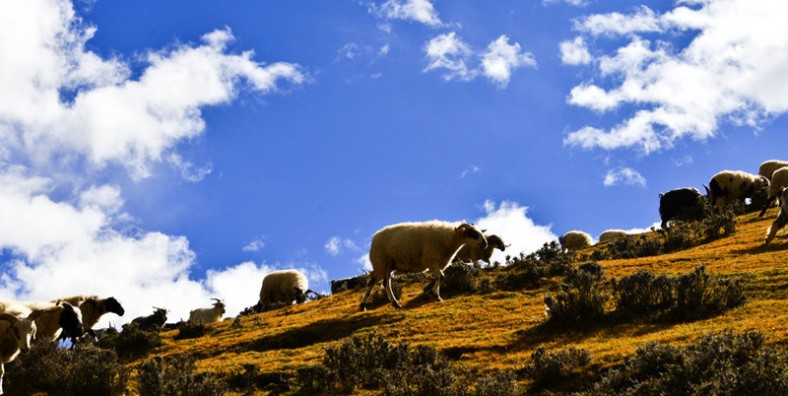
Tour Overview
This 22 days Northwestern Tibet Overland Tour covers most area of the middle, western and northern Tibet, including the rarely visited uninhabited land- North Changtang Wild Land, which is...
Code of Tour: YCT0000003543
Length of Travel: 22 Day
Destinations of Tour: Lhasa-Gyangtse-Shigatse-Mt.Everest-Manasarover-Mt.Kailash-Guge-Ali-Gegye-Gertse-Dong tso-Nyma-Banger-Namtso-Lhasa
Departure City: Lhasa
Price of Tour: Request
Type of Tour:
Features of Tour: Hiking Culture Minority Landscape Wildlife
This 22 days Northwestern Tibet Overland Tour covers most area of the middle, western and northern Tibet, including the rarely visited uninhabited land- North Changtang Wild Land, which is a paradise of more than 230 species of wild animals, including the wild yak, wild donkey, white-lip deer, brown bear and the endangered Tibetan antelope or chiru. This route will take you to explore the rich Tibetan cultural heritages in the three cultural tourist cities: Lhasa, Shigatse and Gyantse, and have an eyeful of the ever-changing natural scenery on the Tibet highland, for instance, the majestic ranges and snow-capped peaks, Mount Everest and Mount Kailash, and the beautiful holy lakes, such as the well-known Yamdrok, Manasarovar, Namtso, Selin-tso and Dangreyong-tso. Of course, you will witness two most significant historical sites in Tibet, the world-known Potala Palace and the mysterious ruins of Guge Kingdom. In a word, this route is a collection of the best of Tibet.
Highlights:
- Experience the Tibetan Buddhism in the main monasteries in Lhasa city and along your way;
- Enjoy the starry sky and stunning sunrise of the highest mountian in the world-Mt. Everest;
- Trekking the most sacred and mythical mountain in the world-Mt. Kailash;
- Explore the paradise of wild lives-Changtang Wild Land;
- Meet snown mountains, tranquil lakes, shimmering rivers, Tibetan villages and rare animals on your way.
Brief Itinerary
- Day 1: Lhasa Arrival
- Day 2: Lhasa
- Day 3: Lhasa
- Day 4: Lhasa-Gyantse
- Day 5: Gyantse-Sakya
- Day 6: Sakya-Rongphu
- Day 7: Rongphu-Saga
- Day 8: Saga-Lake Manasarovar
- Day 9: Lake Manasarovar-Darchen
- Day 10: Darchen-Drirapuk
- Day 11: Drirapuk-Dzutrpuk
- Day 12: Dzutripuk-Darchen
- Day 13: Darchen-Zanda
- Day 14: Zanda-Ali
- Day 15: Ali-Gegye
- Day 16: Gegye-Nyima
- Day 17: Nyima-Dangra Yumtso
- Day 18: Dangra Yumtso-Nyima
- Day 19: Nyima-Selin Tso
- Day 20: Selin Tso-Namtso
- Day 21: Namtso-Lhasa
- Day 22: Lhasa Departure
Google Map
Detailed Itinerary
Day 1 Arrival in Lhasa(3650m)
Sightseeing and Activities:Arrive in Lhasa
Accommodation:None
Meals:None
When you arrive in Lhasa either by train or flight, your guide will greet you and take you to your hotel .An route to viewing the Yarlung Tsangpo River/ Bhamaputra river (the Longest and largest river in Tibet) and Lhasa river. After arrive in Lhasa, you can take rest and acclimatize. If you feel to go out, then you can go to the Potala square, where you will enjoy the fountain with different color and get amazing photos of the Potala and around. Stay overnight in Lhasa.
Day 2 Lhasa
Sightseeing and Activities:Potala Palace, Jokhang temple, Barkhor Street
Accommodation:Lhasa
Meals:Breakfast, Lunch
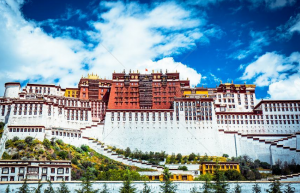
Today’s tour will first bring you to the Potala Palace, the winter palace of the Dalai Lama. It has been used since the 7th Century by the 33rd great king of Tibet. The most valuable collection are the gilded burial stupas of past Dalai Lamas and meditation Cave of the 33rd great king of Tibet.
After you take lunch and then head to Jokhang Temple which was founded by the 33rd great king of Tibet in the 7th century, in order to promote the Buddhist religion. Inside you can see the statue of Buddha Sakyamuni at the age of twelve, perhaps the single most venerated object in Tibet Buddhism.
Around the temple Barkhor Street where you can do kora (circling the Barkhor street) with pilgrims and locals and buy the souvenirs. Stay overnight in Lhasa.
Day 3 Lhasa
Sightseeing and Activities: Drepung Monastery, Carpet factory, Sera Monastery
Accommodation:Lhasa
Meals:Breakfast, Lunch
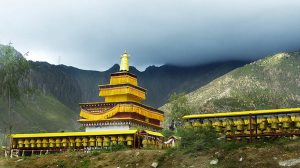
In the morning, you are going to visit Drepung Monastery which was one of the “three greet” Gelug monasteries of Tibet and was founded in 1416 by Jamyang choge, one of the Tsongkhapa’s main disciples. Ganden palace is used as Dalai lama’s palace in the Drepung before moving to the Potala palace.
Afternoon, Sera Monastery—It was one of the “three great” Gelug monasteries of Tibet and was founded in 1419 by Jamchen chojey, one of the Tsongkhapa’s main disciples. The highlight is the Monks debate at around 3 – 5 in the afternoon. Stay overnight in Lhasa.
Day 4 Lhasa (3650m) to Gyantse (3950m)
Sightseeing and Activities:Yamdrok-tso Lake, Mount Nyenchen Khangsar, Pelkor Monastery and Gyantse Kumbum
Accommodation:Gyantse
Meals:Breakfast, Lunch

Today, we have to drive from Lhasa to Gyantse. On the way, the group will pass over the Kambala Pass (4790 m),and tourists will have a glimpse of Yamdrok-tso (4400m) .The Lake is surrounded by many snow-capped mountain and in the distance you have spectacular views of Holy Mount Nyenchen Khangsar, (7191m) the highest mountain near Lhasa .We head westward along the lake and drive towards Gyantse. Gyantse was historically Tibet’s third largest city (after Lhasa and Shigatse). In Gyantse, we will visit the famous Pelkor Monastery(also known as Gyantse Kumbum). The Kumbum has nine floors and each tier has unique chapels. It is considered the largest stupa in Tibet. Stay overnight in Gyantse.
Day 5 Gyantse(3950m) to Sakya(4300m)
Sightseeing and Activities:Tashi Lhunpo Monastery,Sakya Monastery
Accommodation:Sakya
Meals:Breakfast, Lunch

In the Morning, we drive towards Shigatse. In Shigatse, you will visit the famous Tashilhunpo Monastery where you can see the well-preserved largest statue of Jampa (future Buddha) in the world. This monastery is the seat of Tibet’s second highest incarnation, the Panchen Lama. In the afternoon we drive to the Sakya County where tourists can visit the famous Sakya Monastery. It was founded in 1073 and was the principal monastery of the Sakya sect of Tibetan Buddhism. Sakya monastery consists of two parts, northern and southern monastery. The Northern monastery is only visible as a ruin while Southern monastery was built like a fortress, surrounded by a moat. Stay overnight in Sakya.
Day 6 Sakya – Rongbuk Monastery
Sightseeing and Activities:Rongpuk Monastery, Mt. Everes Base Camp
Accommodation:Rongbuk Hostel
Meals:Breakfast, Lunch
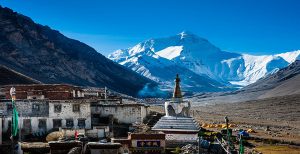
There is about 5-6 hours driving from Sakya to Rongpuk. The road is under construction. From Tingri to E.B.C the road is extremely bumpy and we have to pass the wild grassland, cross the torrent and high mountains. Pay a visit to Rongbuk Monastery.
If it is in clear whether, you can have a glimpse of 4 mountains which are 8000m high or more, i.e. Mt. Lhotse (8516m), Mt. Everest (8848m), Mt. Cho Oyu (8201m) and Mt. Mayalu (8463m). Stay overnight in Ronguk Guest House or Tent.
Day 7 Drive to Sagar County(290km)
Sightseeing and Activities:Mt. Everest,Shishapangma
Accommodation:Saga
Meals:Breakfast, Lunch
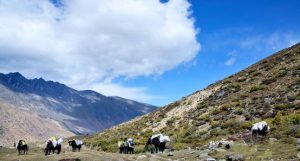
We need to take the old Tingri road to Sagar county. From the old Tingri, you can see the Mount Everest and Shishapangma at 8012m, which is the least of the world’s 8000m peaks to be climbed. The road condition worsens from old tingri and runs parallel to the Himalayan ranges and Nepalian sides called Anapurna ranges.
The main road passes through the desolate plain of Digur tang, with its enormous sand dunes and the closely neighboring snow peaks of Shishapangma and langtang to the south. Leave the BUM-CHU basin, and then descend into the depression of Pelkhu-tso Lake (4600m), a cobalt blue lake. Saga county is only 69km from the Phelgu tso and spend a night in sagar town.
Day 8 Move Saga to Lake Manasarovar(500km)
Sightseeing and Activities:Lake Manasarovar
Accommodation:Camping
Meals:Breakfast, Lunch

You are moving towards the Drongpa county. The region around the sources of Brahmaputra river is about 167km from the sagar town. Then you will reach a tiny dusty town on the main road with a couple of basic guest houses, restaurants and a small monastery called “old Drongpa”.
Around the monastery, you can see a pile of yak heads which is carved with “sutras” and “mantras” like “OM MA NI PAD MEY HUM”, which is mantra of god of compassion. And new Drongpa is a small town with a couple of shops, hotels and restaurant is about 25km apart from the old drongpa. Move towards the Baryang with 4750m above sea level and drive to Lake Manasarovar. Camping by the lake.
Day 9 Spend a day around Manasarovar lake, Then to Darchen to prepare your trekking(30km)
Sightseeing and Activities:Lake Manasarovar
Accommodation:Darchen
Meals:Breakfast, Lunch
Relax around the lake shore and explore the natural beauty of the lake. In summer, flocks of swans will gather on the lake, bringing grace and life to the area. You can not only see many Tibetans and Hindus praying and circling around the lake shore for the whole day, but also see snow-capped mountains on the background and hundreds of swans gather on the lake will attract hundreds of thousands tourists from all over the world.
Day 10 Trek day one(Outer circuit), Darchen to Drirapuk 11km
Sightseeing and Activities:trekking around Mount Kailash
Accommodation:Camping
Meals:Breakfast, Lunch
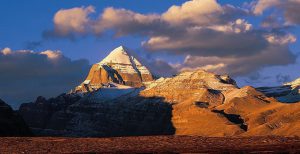
Traditionally, pilgrim undertakes 52 km trekking circuit around Mount Kailash, commencing at darchen(4574m) and crossing the Dolma-la Pass on the second day. Darchen is the starting and completion point for the general circuit of the sacred mount. A few kilometers after leaving Darchen, there is a valley called “sarshung” where porters are waiting for their client. They will help the client to take every necessary thing on yaks and horses. After two hours, you came upon a grassy plain with populated by nomads. You can refresh yourself in nomadic tent by drinking some soft drinks. From this turn in the valley, it is another two hours at least before reaching Drirapuk(4920m). You need to camp or rest in monastery’s guest house, made from cement with little bit good facilities than others in Drirapuk. At the opposite side of Drirapuk, you can see small monastery with its guest house little bit cleaner than others. Camping.
Day 11 Trek day two, Drirapuk to Dzultripuk 22km
Sightseeing and Activities:Lhachu valley floor
Accommodation:Camping
Meals:Breakfast, Lunch
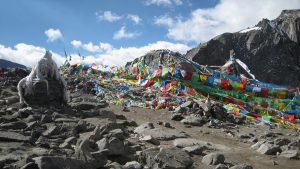
Day two: The second day is the hardest and most tough circuit with the Dolma-la Pass lies 6.4km ahead but 762m above Drirapuk. The peak of Dolma-la pass is about 5630m above sea level, so it is better to set off early in the morning as the sun’s ray break over the ridges. After taking a rest on the peak of Dolma-la pass, you will descend staircase to Lhachu valley floor, about one hour from the pass. It is still four hours trekking to get to the final destination with no shelters in between. It is better to walk on the right side of the river and finally reach to Dzultripuk(miracle cave of milarepa). It is advised to get there before other groups because of limited number of rooms available in Dzultripuk. Take a good rest in the guest room and prepare for next morning’s departure. Camping.
Day 12 Trek day three- Dzultripuk to Darchen-11km:Milarepa’s cave
Sightseeing and Activities:Milarepa’s cave
Accommodation:Darchen
Meals:Breakfast, Lunch
The tour guide will arrange your time and ask him/her to visit the caves and the temples and shrines that have been built around Milarepa’s cave. Then walking back to Darchen is easy and the exit from the valley can be reached within three hours. At the ending point of valley, the driver will take you back to Darchen. Stay overnight in Darchen.
Day 13 Darchen to Zanda, visit Guge Kingdom and Torling Monastery
Sightseeing and Activities:Sightseeing on the way, Toling monastery
Accommodation:Zanda
Meals:Breakfast, Lunch

It is about an eight-hour driving from Darchen to Zanda, though the distance is only about 243km. After several hours of zigzagging down and up fantastically eroded gorges and gullies, we enter wider Sutlej Valley and finally reach Zanda after crossing a bridge. Tsamda county is the current name for the region and was known as Guge kingdom. The capital of the county is located at Toling. Toling Monastery, founded by Richen zangpo in the 10th century, was once Ngari’s most important monastic complex.
It was due to the influence of Richen Zangpo that Toling became the main religious centre of Guge kingdom after inviting the great Indian master ATISHA. The kings of GUGE replaced the city as a political centre of power by establishing capital slightly closer to the Indo-Tibetan trade routes. But the monastery is still an important cultural heritage of Ngari. Stay overnight in Zanda.
Day 14 Zanda to Sanggye khabab(Ali)
Sightseeing and Activities:landscapes on the way to Ali
Accommodation:Ali
Meals:Breakfast, Lunch
Explore various landscapes on the way to Ali. The capital of Ngari prefecture has nothing special to visit but it is a good place to clean up. Indus river is derived from Mount Kailash and flows through this region and finally towards into Pakistan. Sanggai-khabab, the capital of Ali prefecture is a modern city with centre of administration, business and shopping. Take a rest for one night.
Day 15 Sanggye khabab-Gegye-Gertse
Sightseeing and Activities:Golden ducks and large black-necked cranes
Accommodation:Gertse
Meals:Breakfast, Lunch
Drive eastwards from Ali to Gegye(115km), there is nothing much to see but is a good place to clean up. From Gegye to Gertse, you will cross the infant Indus river and then soon enter a marshland with an abundance of birdlife, including golden ducks and large black-necked cranes.
Day 16 Gegye-Nyima
Sightseeing and Activities:Qingtang Grassland and lakes
Accommodation:Nyima
Meals:Breakfast, Lunch
Set off in the morning for Nyima, a small town in north Tibet. The road of Gertse to Nyima is muddy and we need almost one day to reach there. On the way, you can explore the nature of Changtang Grassland and lakes.
Day 17 Nyima to Dangra Yumtso
Sightseeing and Activities:Dangra YumTso Lake
Accommodation:Camping
Meals:Breakfast, Lunch
In the morning, leave for Dangra YumTso. Dangra Yum Tso is 4500m above sea level and the home to many wild animals, such as wild donkey, Tibetan antelope, and wild deer etc. The lake is also a divine lake to the local Bonpa believers. You can expect a warm hospitality when engaging with the locals who are in very unique costumes. Camping by Dangra YumTso.
Day 18 Dangra Yumtso to Nyima
Sightseeing and Activities:Dangra YumTso Lake
Accommodation:Nyima
Meals:Breakfast, Lunch
The rest of the day in Dangra YumTso before transferring back to Nyima in the afternoon, you can hike along the lake to take lots of photographs in the morning. Stay overnight in a basic guesthouse or camping.
Day 19 Nyima to Kanglung Tso to Selin Tso
Sightseeing and Activities:Kanglung Tso lake, black-necked crane nature reserve
Accommodation:Camping
Meals:Breakfast, Lunch
On the way to Selin Tso, you can see much rare wildlife. Make a stopover at Kanglung Tso lake (4500m) en route. Selin Tso is Tibet’s second largest lake, and the world’s largest black-necked crane nature reserve. Today is a 6-8hrs drive. Stay overnight in a basic guesthouse or camping.
Day 20 Selin Tso to Banger to Namtso
Sightseeing and Activities:Namtso Lake
Accommodation:Namtso Guest House
Meals:Breakfast, Lunch
It takes eight hours from Selintso to Namtso. The road is still bumpy and muddy, especially after Banger tso. The 4WD drive camp the mountains every soon and has to cross the rivers and mud ponds. Stay overnight at the lake shore of Namtso.
Day 21 Namtso-Lhasa
Sightseeing and Activities:Namtso lake, Tashi Island
Accommodation:Lhasa
Meals:Breakfast, Lunch
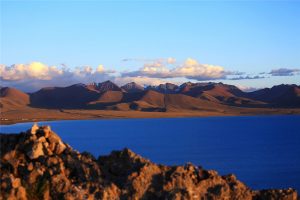
Namtso Lake means “Heaven Lake” in Tibetan. It is one of the three holy lakes of Tibet and the highest lake in the world with an elevation 4,718 meters above sea level. With a length of 70 kilometers from west to east and a width of 30 kilometers from north to south, it covers an area of 1,920 square kilometers. Namtso is acclaimed to be the largest lake in Tibet and the second largest salty lake in China. Explore along the lake for a half day. You can hike from camp on the Tashi Island along the lake shore for several kms. Drive to Lhasa after lunch.
Day 22 Leave Lhasa to your next destination by train or by flight
Sightseeing and Activities:None
Accommodation:None
Meals:Breakfast
Our tour guide and driver will see you off at airport or train station to end the pleasant and taxing journey.
Recommended Hotels
| Destination | 5 Star | 4 Star | 3 Star |
| Lhasa | Luxury St. Regis Lhasa Resort | Lhasa Gang Gyan Hotel | Lhasa Xiongbala Hotel |
| Gyantse | / | / | Gyantse Hotel |
| Saga | / | Xibu Yizhan Hotel | Brahmaputra Hotel |
| Darchen | / | / | Darchen New Hotel |
| Zanda | / | / | Yadu Hotel |
| Ali | / | Huahui Yintai Hotel | Ali Yinghe Hotel |
| Nyima | / | / | Wanghu Hotel |
Service Included:
- Admission fees for all of the sightseeing spots listed in the itinerary;
- Meals as listed in the itinerary;
- Accommodation with breakfast as listed in the itinerary;
- Private English-speaking tour guide and vehicle for transfers & sightseeing;
- Service charge & government taxes;
- Luggage transfers between airports and hotels;
- Two bottles of mineral water each day.
Service Excluded:
- Any arrival and departure international airfares or train tickets;
- Chinese visa fees;
- Excess baggage charged by Airlines;
- Single room supplement;
- Tips to guides and drivers;
- Personal expenses and gratuities to service staff;
- Personal travel insurance;
- All optional programs;
- Domestic air tickets fares with airport tax and fuel extra fee based on economy class mentioned in the program.
Travel Tips:
- Tibet Permits
There are several permits required to visit Tibet. Tibet Entry Permit, issued by Tibet Tourism Bureau, is the most important one which has to be obtained before your trip because you must have it to take your flight/train to Tibet. To get the permit, you have to book a Tibet tour with us, and send us your passport and Chinese visa about 20 days in advance, and then let us apply for the permit (all Tibet permits can only be applied by travel agency). If you travel to other prefectures like Shigatse, Nyingchi, Shannan, etc, you also have to obtain an Alien Travel Permit. If you travel to Mount Everest, you have to obtain a Border Permit. (Tibet Discovery, with office in Lhasa, has always kept up with the latest news on Tibet Permits. Traveling with us, all your permits are guaranteed as long as you are qualified to the requirements.)
- Available Months to Visit Tibet
Generally speaking, May to early October is the best time to for a Mount Kailash trip. July and August are the peak season and rainy season. It may be too cold to travel in Kailash area from November to March. There is usually heavy snow. The conditions in Namtso Lake and Mount Everest area are quite similar with Kailash. While other places like Lhasa, Gyantse and Shigatse are suitable for travel all year around.
- High Altitude Sickness
The average altitude of Tibet is about 4000 meters above the sea level (Lhasa: 3700m; EBC: 5200m; Namtso: 4718m). You may suffer a bit from High Altitude Sickness in the beginning days of your Tibet trip if you haven’t had rich high plateau travel experience. But don’t worry too much, the high altitude can be acclimatized usually in 2~3 days. Our suggestion is to take a physical examination and get suggestions from your doctor, and also bring some medicines to prevent from High Altitude Sickness before your trip. While in Tibet, you should keep warm all the time, avoid strenuous activities, drink more water and eat more vegetables and carbohydrates. You’d better not take showers during the first two days after your arrival at Tibet. If you don’t feel well, get help from your tour guide or go to the hospital without any delay.
- How to Go to Tibet
Basically you have two options – flight and train. Currently, you can take a flight to Lhasa from Beijing(4.5hrs), Xian(3.7hrs), Chengdu(2.5hrs), Chongqing(3hrs), Kuming(3hrs), etc. Among all these cities, Chengdu and Xian have more frequent flights to Lhasa. Kathmandu also has several flights to Lhasa each week.
If you a train travel, you can take a train to from Beijing(40.5hrs), Xian(32hrs), Chengdu(43hrs), Shanghai(47hrs), Chongqing(42hrs), Lanzhou(25hrs), Xining(22hrs), Guangzhou(54hrs).
- Packing and Wearing Ideas
Firstly you can’t forget your passport and Chinese Visa. A large backpack and a smaller one are recommended (the smaller one can be used for daily activities). Also bring the necessary medicine you need. Other stuffs like sunglasses, snow glasses, hats, lip balm, sun block are recommended. As for wearing, you are suggested to dress in layers (both thin and thick jackets). Down jacket is necessary in Spring and Autumn. A pair of durable and comfortable shoes is necessary.

















